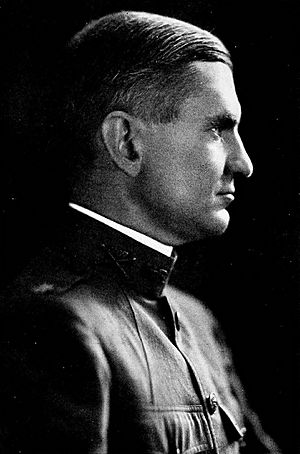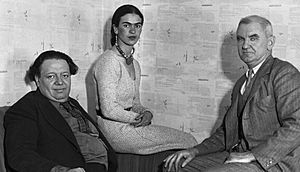Anson Goodyear facts for kids
Quick facts for kids
Anson Goodyear
|
|
|---|---|

Colonel Goodyear, executive officer of the Camp Taylor, Kentucky training school for artillery officers during World War I.
|
|
| President of the Museum of Modern Art | |
| In office 1929–1939 |
|
| Preceded by | Inaugural holder |
| Succeeded by | Nelson Rockefeller |
| Personal details | |
| Born | June 20, 1877 Buffalo, New York |
| Died | April 24, 1964 (aged 86) Old Westbury, New York |
| Spouses |
|
| Children | 4 |
| Parents | Charles W. Goodyear Ella Portia Conger |
| Relatives | Frank H. Goodyear (uncle) George V. Forman (father-in-law) |
| Residence | A. Conger Goodyear House |
| Education | Nichols School |
| Alma mater | Yale University |
Anson Conger Goodyear (born June 20, 1877 – died April 24, 1964) was an American businessman, writer, and a generous helper of good causes (a philanthropist). He was part of the important Goodyear family. He is most famous for being one of the people who started the Museum of Modern Art (MoMA) in New York City. He was also its very first president.
Contents
Early Life and Education
Anson Conger Goodyear was born in Buffalo, New York, on June 20, 1877. He was the oldest of four children. His father, Charles W. Goodyear (1846-1911), was a rich businessman and a friend of President Grover Cleveland. His mother was Ella Portia Conger (1863-1940).
The Goodyear family was very well-known in Western New York. They lived in a large house at 888 Delaware Avenue in Buffalo.
Conger Goodyear went to the Nichols School in Buffalo. He then studied at Yale University and graduated in 1899. While at Yale, he joined student groups like Alpha Delta Phi and the Wolf's Head Society. This is where he started collecting rare books. Later, he added many letters from the famous writer William Makepeace Thackeray to his collection.
Goodyear's Career
Goodyear was a leader in several businesses. He was the president of the Great Southern Lumber Company from 1920 to 1938. This company had a large sawmill in Bogalusa, Louisiana. He also served as vice president of the Marine Midland Bank.
His father and uncle had built railroads to help their lumber businesses. Following this, Goodyear became the vice president of the Buffalo and Susquehanna Railroad (1907–1910). He was also president of the New Orleans Great Northern Railroad Company (1920–1930). This railroad helped transport lumber from Bogalusa.
He was also the chairman of the board for Gaylord Container Corporation. This company took over from the Great Southern Lumber Company. Goodyear was also a director for Paramount Pictures and the Gulf, Mobile and Ohio Railroad. He held leadership roles in many other companies too.
Public Service and Military Work
Goodyear was active in the New York National Guard. During World War I, he was a colonel. He was an executive officer at the Field Artillery Central Officers Training School in Kentucky.
In the 1930s, Goodyear became president of the American National Theater and Academy. After World War I, Herbert Hoover asked Goodyear to lead a special mission. This mission was to manage coal distribution in Austria, Hungary, and Poland.
Goodyear was known for his friendly nature and clever ideas. He helped solve strikes and open borders to get coal moving. He even got Hoover to send him tobacco to give to miners. His unusual methods helped double coal production in Central Europe in just one month.
During World War II, Goodyear was a major general. He commanded the Second Brigade of the New York Guard. Later, he worked for the American Red Cross in the Pacific Ocean area, including Hawaii. He visited battlefronts, traveling 50,000 miles. He also reported to the Secretary of War about conditions and morale of troops.
Art Collector and Museum of Modern Art
Anson Conger Goodyear loved art and collected many pieces. He was known for his generous donations. His personal art collection included important works by Paul Cézanne and Vincent van Gogh. He also owned Paul Gauguin's famous painting Spirit of the Dead Watching. Other artists in his collection included Henri de Toulouse-Lautrec and Pierre-Auguste Renoir.
Three important women, Abby Aldrich Rockefeller, Mary Quinn Sullivan, and Lillie P. Bliss, asked him to help start the Museum of Modern Art (MoMA). This museum was to be in New York City. He became its first president, serving from 1929 to 1939. He also remained a member of MoMA's board of trustees.
Goodyear traveled to Europe at his own expense to find paintings for MoMA's first exhibition. He visited England, France, the Netherlands, and Germany. He borrowed 25 paintings for the museum. In 1939, Nelson Rockefeller took over as MoMA's chief executive.
Goodyear also wrote several books, including:
- A Memoir: John George Milburn, Jr. (1938)
- American Art Today: Gallery of American Art Today, New York World's Fair (1939)
- The Museum of Modern Art. The First Ten Years (1943)
Philanthropy and Donations
Goodyear gave many valuable things to different organizations. In 1953, he donated his collection of Civil War materials to Yale University. This collection included letters, diaries, and other important papers from the Civil War.
By the time he died, Goodyear had donated almost 300 artworks to the Albright–Knox Art Gallery in Buffalo, New York. He also left many important artworks to the museum in his will. These included Giacomo Balla’s Dinamismo di un Cane al Guinzaglio (1912) and Frida Kahlo’s Self-Portrait with Monkey (1938). Before his death, the museum created the A. Conger Goodyear Fund. This fund helps the museum buy new art.
He was a close friend of the famous actress and theater producer Katharine Cornell. After she died, she left some money to MoMA in his honor. Goodyear was also a director of the Buffalo Academy of Fine Arts. He was an honorary governor of the New York Hospital and a donor to Dartmouth College. He also gave donations to Norwich University, where Goodyear Hall is named after him.
Personal Life
On June 29, 1904, Anson Conger Goodyear married Mary Martha Forman (1879–1973). She was the only daughter of George V. Forman, a well-known banker from Buffalo. Before they divorced, Goodyear and Forman had four children:
- George Forman Goodyear (1906–2002)
- Mary Goodyear (1907–1977)
- Anson C. Goodyear, Jr. (1911–1982)
- Stephen Goodyear (1915–1998)
In 1950, he married Zaidee C. Bliss (1881–1966). She was the widow of Cornelius Newton Bliss Jr., a financier.
His home in Old Westbury, New York, called the A. Conger Goodyear House, was built in 1938. This house is now listed on the National Register of Historic Places. Anson Conger Goodyear died in Old Westbury, New York on April 24, 1964. After he passed away, his art collection was given to the Buffalo Academy of Fine Arts.
See also
- A. Conger Goodyear House
- Charles W. Goodyear
- Charles W. Goodyear House
- Museum of Modern Art
- Buffalo Academy of Fine Arts
- Great Southern Lumber Company
- Buffalo and Susquehanna Railroad



